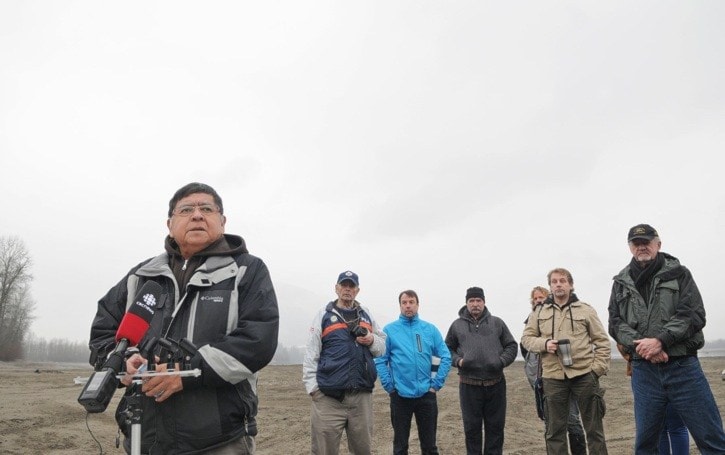The riverside site of a proposed waste recycling plant in Chilliwack is still rocking the boat.
First Nations, environmental and sport fishing reps held a press conference on the shores of the Fraser River Tuesday to express united opposition to the Aevitas Inc. proposal to site a plant just downstream to handle hazardous materials like mercury and PCBs.
They're calling for relocation of the facility and comprehensive public reviews by senior levels of government, like Ministry of Environment and Ministry of Health.
Sto:lo Tribal Council president Clarence Pennier said the riverside location of the facility is "unacceptable" because of the risk it poses.
“The recycling plant will be in the heart of Sto:lo territory and it will be too close to the Fraser River. It's unacceptable because it poses a danger to the river and the salmon."
City council gave the rezoning second and third reading already, and is not legally allowed to accept any new information on the issue. It was a unanimous decision by council on Dec. 3 to rezone a parcel on the Cattermole Lands from its M4 heavy industrial designation, to M6 special industrial zone to allow the construction of a waste recycling plant.
Mayor Sharon Gaetz stated that Chilliwack specifically opted for the M6 'special industrial' designation to give council the ability to impose extra environmental restrictions and conditions that they wouldn't otherwise be able to include.
At the hearing, councillors said they were convinced the work could be done safely by Aevitas Inc. and reports indicated Aevitas has never had a safety incident or complaint in its 20 years of operation at locations in Ontario and Alberta.
But the main concern of those gathered by the Fraser was still the proximity of the proposed facility to the river, and the limits of the public hearing and consultation process.
"I was baffled that they would even consider rezoning for a proposal of that type on a flood plain," Rod Clapton of B.C. Federation of Drift Fishers told The Progress.
Why does he think the Aevitas plant poses a risk necessarily?
"This is an issue that impacts communities all along the Fraser River, which is one of the most productive salmon rivers in the world. Some of the language about the facility refers to that location (on Cannor Road) as posing a moderate flood threat.
"It needs to got where there is zero flood threat," Clapton said.
Aevitas is an industry specialist in the hazardous waste treatment field, with vast experience in safe handling of a range of waste that could otherwise be a danger to communities, according to city staff reports.
"People appreciate that there's a need for a recycling facility like this, but let's get it above ground where it can be sealed off and self-contained," said Clapton. And if the "big one hits," he says, those measures may not help in any case.
Aevitas has said the plant will have an odour control system, geo membranes, and recycling activities will be conducted indoors. The plan calls for internal containment, fire suppression and other safeguards, like building above the flood plain, and clay linings.
City officials have said there is no recourse at this point for officially re-examining the matter of the location of the waste recycling facility in the Cattermole Business Park on Cannor Road.
"It's true that city council did do their due diligence, in allowing the public hearing to proceed," said Sheila Muxlow of WaterWealth. "But that said, because this has such far-reaching impacts on something as essential as our waterways, it is also shining a light on how that process doesn't work for all the developments that come our way on the local level."
It's just common sense, she says, since it's hard to imagine a facility like the one proposed for Chilliwack "not leaching" eventually into local waters, Muxlow warned, not only in the case of a major flood, but because of the vertical angle of the terrain flowing downward on this property.
The community could look at developing a "watershed sustainability plan," she suggested, "we could flag these high-interest areas well in advance of any projects that might pose a risk to the waterways."
The Watershed Sustainability Act is heading in that direction, and creates room for a shift in jurisdiction from provincial to local concern if there is a sustainability plan.
So the Fraser River location is a key concern in the Aevitas project but also it's to look at the process of making decisions like these, and the need for more public consultation.
A city staff report estimated the facility will treat 5,000 litres of transformer oil containing PCBs and 500,000 lamps containing mercury each month. In addition the facility will be used as a transfer station for wastes including flammable, corrosive, toxic and infectious materials.
"For us one of the main concerns is the wild salmon," said Lina Azeez of Watershed Watch Salmon Society. "We don't see it as just a Chilliwack issue, as it definitely affects everyone on the Lower Fraser."
If there's enough public outcry, maybe an alternate site can be found on another industrial property, which is not located in the flood plain, Azeez added.
"We'd like it to be somewhere without even the minutest risk of impacting salmon and other creatures."
The Aevitas recycling facility application is now pending the signing of the restrictive covenant, which includes an emergency evacuation clause in the event of high water, as well as approval by Ministry of Environment.
jfeinberg@theprogress.com
Twitter.com/chwkjourno
